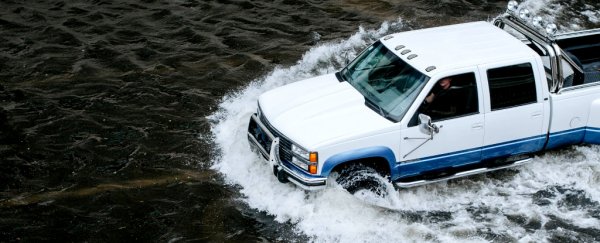For years, scientists have warned of the "next big one," an earthquake so powerful that it could topple buildings, slash power, and take lives across California.
As far as natural disasters go, the quake represented the worst-case-scenario for cities like Los Angeles and San Francisco, which are both located along the San Andreas Fault.
Now government experts claim there's an even bigger threat to California residents: a potential mega-storm that could inundate cities and cause up to US$725 billion in damage.
That's more than double the damage that could hail from the "next big one," according to the latest estimates from data analytics firm CoreLogic.
In 2011, a team of scientists and other experts at the US Geological Survey (USGS) likened the mega-storm to the California winter storms of 1861 and 1862, which killed thousands and left a 300-mile-long (482-kilometre-long) lake in the center of the state.
The future doomsday scenario – known "Atmospheric River 1,000", or ARkstorm for short – could surpass levels of precipitation that are only seen every 500 to 1,000 years.
If ARkstorm does hit, its effects could be exacerbated by the failure of a single piece of infrastructure: the Whittier Narrows Dam in Los Angeles County.
A recent report from the US Army Corps of Engineers (USACE) found that ARkstorm could breach the dam, causing water to spill over the top or triggering the premature release of the dam's spillway.
The resulting floods and landslides pose an "unacceptable" risk to human lives, the report said.
Already, California's flood-protection systems have showed signs of malfunction in places like the Central Valley and the San Francisco Bay Area. In 2017, the near-failure of the Oroville Dam outside Sacramento prompted the evacuation of more than 180,000 people.
The USACE points to the Whittier Narrows Dam as "one of the highest risk dams" in their portfolio.
If their models are borne out, around 1.5 million people could be forced to evacuate due to catastrophic flooding, with some areas witnessing floods of up to 20 feet (6 metres). As weather conditions worsen due to climate change, these predictions could become even graver.
Though scientists can't pinpoint when ARkstorm or the next big earthquake will occur, both disasters are considered likely, if not inevitable.
But the USGS has found that preparations for the "next big one" could help combat a storm as well.
By setting up shelters, testing aid agreements, and piloting early warning apps, the state can ready itself for whichever disaster comes first.
This article was originally published by Business Insider.
More from Business Insider:
